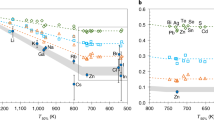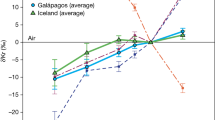Abstract
The origin of Earth’s volatiles has been attributed to a late addition of meteoritic material after core–mantle differentiation. The nature and consequences of this ‘late veneer’ are debated, but may be traced by isotopes of the highly siderophile, or iron-loving, and volatile element selenium. Here we present high-precision selenium isotope data for mantle peridotites, from double spike and hydride-generation multicollector inductively coupled plasma mass spectrometry. These data indicate that the selenium isotopic composition of peridotites is unaffected by petrological processes, such as melt depletion and melt-rock reaction, and thus a narrow range is preserved that is representative of the silicate Earth. We show that selenium isotopes record a signature of late accretion after core formation and that this signature overlaps only with that of the CI-type carbonaceous chondrites. We conclude that these isotopic constraints indicate the late veneer originated from the outer Solar System and was of lower mass than previously estimated. Thus, we suggest a late and highly concentrated delivery of volatiles enabled Earth to become habitable.
This is a preview of subscription content, access via your institution
Access options
Access Nature and 54 other Nature Portfolio journals
Get Nature+, our best-value online-access subscription
$29.99 / 30 days
cancel any time
Subscribe to this journal
Receive 12 print issues and online access
$259.00 per year
only $21.58 per issue
Buy this article
- Purchase on Springer Link
- Instant access to full article PDF
Prices may be subject to local taxes which are calculated during checkout


Similar content being viewed by others
References
Marty, B. The origins and concentrations of water, carbon, nitrogen and noble gases on Earth. Earth Planet. Sci. Lett. 313–314, 56–66 (2012).
Fischer-Gödde, M. & Kleine, T. Ruthenium isotopic evidence for an inner Solar System origin of the late veneer. Nature 541, 525–527 (2017).
Morbidelli, A. et al. Source regions and timescales for the delivery of water to the Earth. Meteorit. Planet. Sci. 35, 1309–1320 (2000).
Albarède, F. Volatile accretion history of the terrestrial planets and dynamic implications. Nature 461, 1227–1233 (2009).
Wang, Z. & Becker, H. Ratios of S, Se and Te in the silicate Earth require a volatile-rich late veneer. Nature 499, 328–331 (2013).
McDonough, W. F. & Sun, S-s. The composition of the Earth. Chem. Geol. 120, 223–253 (1995).
Chou, C.-L. Fractionation of siderophile elements in the Earth’s upper mantle. Lunar Planet. Sci. Conf. Proc. IX, 219–230 (1978).
Walker, R. J. Highly siderophile elements in the Earth, Moon and Mars: update and implications for planetary accretion and differentiation. Chem. Erde Geochem. 69, 101–125 (2009).
Rose-Weston, L., Brenan, J. M., Fei, Y., Secco, R. A. & Frost, D. J. Effect of pressure, temperature, and oxygen fugacity on the metal–silicate partitioning of Te, Se, and S: implications for Earth differentiation. Geochim. Cosmochim. Acta 73, 4598–4615 (2009).
Mann, U., Frost, D. J., Rubie, D. C., Becker, H. & Audétat, A. Partitioning of Ru, Rh, Pd, Re, Ir and Pt between liquid metal and silicate at high pressures and high temperatures—implications for the origin of highly siderophile element concentrations in the Earth’s mantle. Geochim. Cosmochim. Acta 84, 593–613 (2012).
Brenan, J. M. & McDonough, W. F. Core formation and metal–silicate fractionation of osmium and iridium from gold. Nat. Geosci. 2, 798–801 (2009).
Walker, R. J. et al. Comparative 187Re–187Os systematics of chondrites: implications regarding early Solar System processes. Geochim. Cosmochim. Acta 66, 4187–4201 (2002).
Meisel, T., Walker, R. J., Irving, A. J. & Lorand, J.-P. Osmium isotopic compositions of mantle xenoliths: a global perspective. Geochim. Cosmochim. Acta 65, 1311–1323 (2001).
Warren, P. H. Stable-isotopic anomalies and the accretionary assemblage of the Earth and Mars: a subordinate role for carbonaceous chondrites. Earth Planet. Sci. Lett. 311, 93–100 (2011).
Kruijer, T. S., Burkhardt, C., Budde, G. & Kleine, T. Age of Jupiter inferred from the distinct genetics and formation times of meteorites. Proc. Natl Acad. Sci. USA 114, 6712–6716 (2017).
König, S., Lorand, J.-P., Luguet, A. & Pearson, D. G. A non-primitive origin of near-chondritic S–Se–Te ratios in mantle peridotites; implications for the Earthʼs late accretionary history. Earth Planet. Sci. Lett. 385, 110–121 (2014).
Yierpan, A., König, S., Labidi, J. & Schoenberg, R. Selenium isotope and S–Se–Te elemental systematics along the Pacific–Antarctic ridge: role of mantle processes. Geochim. Cosmochim. Acta 249, 199–224 (2019).
Alexander, C. M. O. D. et al. The provenances of asteroids, and their contributions to the volatile inventories of the terrestrial planets. Science 337, 721–723 (2012).
Labidi, J., König, S., Kurzawa, T., Yierpan, A. & Schoenberg, R. The selenium isotopic variations in chondrites are mass-dependent; implications for sulfide formation in the early Solar System. Earth Planet. Sci. Lett. 481, 212–222 (2018).
Yierpan, A. et al. Chemical sample processing for combined selenium isotope and selenium–tellurium elemental investigation of the Earth’s igneous reservoirs. Geochem. Geophys. Geosyst. 19, 516–533 (2018).
Kurzawa, T., König, S., Labidi, J., Yierpan, A. & Schoenberg, R. A method for Se isotope analysis of low ng-level geological samples via double spike and hydride generation MC–ICP–MS. Chem. Geol. 466, 219–228 (2017).
Lorand, J.-P. & Alard, O. Determination of selenium and tellurium concentrations in Pyrenean peridotites (Ariege, France): new insight into S/Se/Te systematics of the upper in mantle samples. Chem. Geol. 278, 120–130 (2010).
Lorand, J.-P. & Alard, O. Platinum-group element abundances in the upper mantle: new constraints from in situ and whole-rock analyses of Massif Central xenoliths (France). Geochim. Cosmochim. Acta 65, 2789–2806 (2001).
Lorand, J.-P., Alard, O., Luguet, A. & Keays, R. R. Sulfur and selenium systematics of the subcontinental lithospheric mantle: inferences from the Massif Central xenolith suite (France). Geochim. Cosmochim. Acta 67, 4137–4151 (2003).
Harvey, J., König, S. & Luguet, A. The effects of melt depletion and metasomatism on highly siderophile and strongly chalcophile elements: S–Se–Te–Re–PGE systematics of peridotite xenoliths from Kilbourne Hole, New Mexico. Geochim. Cosmochim. Acta 166, 210–233 (2015).
Kurzawa, T., König, S.J. C., Yierpan, A. & Schoenberg, R. The role of subduction recycling on the selenium isotope signature of the mantle: constraints from Mariana arc lavas. Chem. Geol. 513, 239–249 (2019).
Rouxel, O., Ludden, J., Carignan, J., Marin, L. & Fouquet, Y. Natural variations of Se isotopic composition determined by hydride generation multiple collector inductively coupled plasma mass spectrometry. Geochim. Cosmochim. Acta 66, 3191–3199 (2002).
Scott, E. R. D. & Krot, A. N. in Treatise on Geochemistry 2nd edn (eds Holland, H. D. & Turekian, K. K.) 65–137 (Elsevier, 2014).
Labidi, J., Cartigny, P. & Moreira, M. Non-chondritic sulphur isotope composition of the terrestrial mantle. Nature 501, 208–211 (2013).
Suer, T.-A., Siebert, J., Remusat, L., Menguy, N. & Fiquet, G. A sulfur-poor terrestrial core inferred from metal–silicate partitioning experiments. Earth Planet. Sci. Lett. 469, 84–97 (2017).
Palme, H. & O’Neill, H. S. C. in Treatise on Geochemistry 2nd edn (eds Holland, H. D. & Turekian, K. K.) 1–39 (Elsevier, 2014).
Righter, K., Humayun, M. & Danielson, L. Partitioning of palladium at high pressures and temperatures during core formation. Nat. Geosci. 1, 321–323 (2008).
Fischer-Gödde, M. & Becker, H. Osmium isotope and highly siderophile element constraints on ages and nature of meteoritic components in ancient lunar impact rocks. Geochim. Cosmochim. Acta 77, 135–156 (2012).
Hopp, T. & Kleine, T. Nature of late accretion to Earth inferred from mass-dependent Ru isotopic compositions of chondrites and mantle peridotites. Earth Planet. Sci. Lett. 494, 50–59 (2018).
Creech, J. B. et al. Late accretion history of the terrestrial planets inferred from platinum stable isotopes. Geochem. Perspect. Lett. 3, 94–104 (2017).
Creech, J. B., Moynier, F. & Bizzarro, M. Tracing metal–silicate segregation and late veneer in the Earth and the ureilite parent body with palladium stable isotopes. Geochim. Cosmochim. Acta 216, 28–41 (2017).
Fischer-Gödde, M. et al. Ruthenium isotope constraints on the timing of volatile element accretion. Goldschmidt Abstr. 2018, 722 (2018).
Day, J. M. D., Walker, R. J. & Warren, J. M. 186Os–187Os and highly siderophile element abundance systematics of the mantle revealed by abyssal peridotites and Os-rich alloys. Geochim. Cosmochim. Acta 200, 232–254 (2017).
Dasgupta, R., Chi, H., Shimizu, N., Buono, A. S. & Walker, D. Carbon solution and partitioning between metallic and silicate melts in a shallow magma ocean: implications for the origin and distribution of terrestrial carbon. Geochim. Cosmochim. Acta 102, 191–212 (2013).
Schönbächler, M., Carlson, R. W., Horan, M. F., Mock, T. D. & Hauri, E. H. Heterogeneous accretion and the moderately volatile element budget of Earth. Science 328, 884–887 (2010).
Bergin, E. A., Blake, G. A., Ciesla, F., Hirschmann, M. M. & Li, J. Tracing the ingredients for a habitable earth from interstellar space through planet formation. Proc. Natl Acad. Sci. USA 112, 8965–8970 (2015).
Carignan, J. & Wen, H. Scaling NIST SRM 3149 for Se isotope analysis and isotopic variations of natural samples. Chem. Geol. 242, 347–350 (2007).
König, S., Lissner, M., Lorand, J.-P., Bragagni, A. & Luguet, A. Mineralogical control of selenium, tellurium and highly siderophile elements in the Earth’s mantle: evidence from mineral separates of ultra-depleted mantle residues. Chem. Geol. 396, 16–24 (2015).
König, S., Luguet, A., Lorand, J.-P., Wombacher, F. & Lissner, M. Selenium and tellurium systematics of the Earth’s mantle from high precision analyses of ultra-depleted orogenic peridotites. Geochim. Cosmochim. Acta 86, 354–366 (2012).
Vollstaedt, H., Mezger, K. & Leya, I. The isotope composition of selenium in chondrites constrains the depletion mechanism of volatile elements in Solar System materials. Earth Planet. Sci. Lett. 450, 372–380 (2016).
Zhu, J.-M., Johnson, T. M., Clark, S. K. & Xiang-Kun, Z. High precision measurement of selenium isotopic composition by hydride generation multiple collector inductively coupled plasma mass spectrometry with a 74Se–77Se double spike. Chin. J. Anal. Chem. 36, 1385–1390 (2008).
Lorand, J.-P., Luguet, A., Alard, O., Bezos, A. & Meisel, T. Abundance and distribution of platinum-group elements in orogenic lherzolites; a case study in a Fontete Rouge lherzolite (French Pyrénées). Chem. Geol. 248, 174–194 (2008).
Acknowledgements
This work was supported by the ERC Starting Grant 636808 (O2RIGIN) granted to S.K. We thank T. Kurzawa and E. Reitter for laboratory assistance.
Author information
Authors and Affiliations
Contributions
S.K. designed the project, J.-P.L. provided the samples and their relevant petrogenetic features, M.I.V.-R. prepared the samples and performed the Se isotope analysis and, together with S.K. and A.Y., interpreted the data and wrote the manuscript with contributions from all the authors.
Corresponding author
Ethics declarations
Competing interests
The authors declare no competing interests.
Additional information
Publisher’s note: Springer Nature remains neutral with regard to jurisdictional claims in published maps and institutional affiliations.
Supplementary information
Supplementary Information
Supplementary Notes, Supplementary Table Captions 1–7, Supplementary Figs. 1–3 and Supplementary References.
Supplementary Tables
Supplementary Tables 1–7.
Rights and permissions
About this article
Cite this article
Varas-Reus, M.I., König, S., Yierpan, A. et al. Selenium isotopes as tracers of a late volatile contribution to Earth from the outer Solar System. Nat. Geosci. 12, 779–782 (2019). https://doi.org/10.1038/s41561-019-0414-7
Received:
Accepted:
Published:
Issue Date:
DOI: https://doi.org/10.1038/s41561-019-0414-7
This article is cited by
-
Importance of asteroid sample return
Nature Geoscience (2023)
-
Nitrogen isotope evidence for Earth’s heterogeneous accretion of volatiles
Nature Communications (2022)
-
Late veneer and the origins of volatiles of Earth
Acta Geochimica (2022)
-
Contribution of Ryugu-like material to Earth’s volatile inventory by Cu and Zn isotopic analysis
Nature Astronomy (2022)
-
Sulfur isotopic signature of Earth established by planetesimal volatile evaporation
Nature Geoscience (2021)



